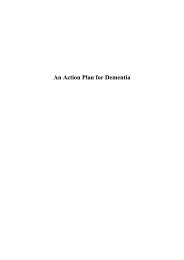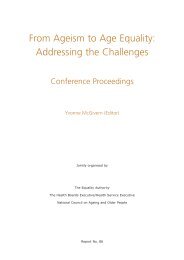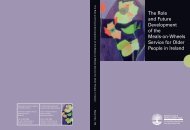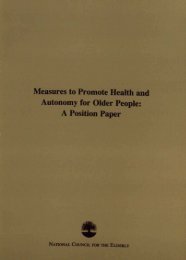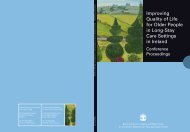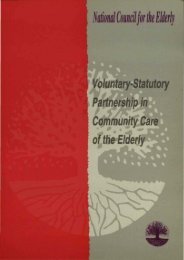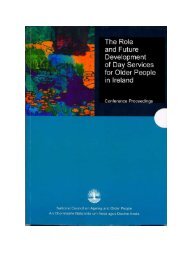Assessment of Older People's Health and Social Care Needs and ...
Assessment of Older People's Health and Social Care Needs and ...
Assessment of Older People's Health and Social Care Needs and ...
- No tags were found...
Create successful ePaper yourself
Turn your PDF publications into a flip-book with our unique Google optimized e-Paper software.
The calculation <strong>of</strong> risk is highly complex: ironically, some <strong>of</strong> the protective measures undertaken byolder people (Iow mileage <strong>and</strong> low speeds) may conspire to present a spuriously high risk per miledriven". Also older people are more frail <strong>and</strong> crashes involving the elderly are also more likely to befatal, by a factor <strong>of</strong> 3.5 in two-car accidents". Janke has suggested a reasonable interpretation <strong>of</strong>these apparently contradictory findings". A group's average crash rate per year may be considered asan indicator <strong>of</strong> the degree <strong>of</strong> risk posed to society by that group, whereas average accident rate permile indicates the degree <strong>of</strong> risk posed to individual drivers in the group when they drive, as well astheir passengers. The increased risk to individual drivers is most likely due to age-related illnesses,particularly neurodegenerative <strong>and</strong> vascular diseases"·"·38rather than to age per se.Two opposing Viewpoints have been taken on the likely impact <strong>of</strong> increasing numbers <strong>of</strong> older driverson crash trends. The most alarmist viewpoint is that the number <strong>of</strong> elderly traffic fatalities will morethan triple by the year 2030, based on current rates. If this expected increase occurs, the number <strong>of</strong>elderly traffic fatalities in 2030 would be 35 percent greater than the total number <strong>of</strong> alcohol-relatedtraffic fatalities in 1995 39 • A more optimistic approach is a reiteration <strong>of</strong> Smeed's law, wherebyincreasing numbers <strong>of</strong> new drivers in a population display a diminishing number <strong>of</strong> accidents overtime'·.A third problem is that healthcare proViders are placed in an awkward situation in several states inthe US, provinces in Canada <strong>and</strong> a minority <strong>of</strong> countries in Europe. In these jurisdictions it ism<strong>and</strong>atory to report drivers with certain illnesses to driver licencing authorities'"'''. In the absence <strong>of</strong>evidence-based guidelines <strong>and</strong> pathways <strong>of</strong> remediation after reporting, this process does notrepresent a health gain for our patients, <strong>and</strong> may even represent a loss <strong>of</strong> independence. Thatdoctors have a difficulty with this type <strong>of</strong> legislation is typified by the effect <strong>of</strong> the introduction <strong>of</strong>compulsory reporting <strong>of</strong> drivers with dementia to the California Department <strong>of</strong> Motor Vehicles. In theyears following the introduction <strong>of</strong> the legislation, there was no increase in the numbers reported.Although some <strong>of</strong> this under-reporting may stem from ignorance, it is also likely that doctors areunWilling to commit their patients to judgement by a system which is not eVidence-based <strong>and</strong> seemspre-occupied with keeping patients <strong>of</strong>f the road.The medical literature on medical fitness to drive is relatively recent. It reflects societal bias <strong>and</strong> twomajor themes are obvious. These are i) a relative unawareness among doctors <strong>and</strong> the rehabilitationdisciplines <strong>of</strong> the functional <strong>and</strong> medical importance <strong>of</strong> fitness to drive <strong>and</strong> ii) an over-emphasis onselecting those who should not drive rather than on enabling older drivers. Doctors are unaware <strong>of</strong>33 Hakamies-Blomqvist, L., Wahlstrom, B., 'Why do older drivers give up driving?' Accid Anal Prev 1998;30(3):305-12.34 Klamm, E.R .. 'Auto insurance: needs <strong>and</strong> problems <strong>of</strong> drivers 55 <strong>and</strong> ove'. In: Malfetti JL, editor. Drivers 55+: needs<strong>and</strong> problems <strong>of</strong> older drivers: survey results <strong>and</strong> recommendations. Falls Church, VA: AAA Foundation for Road Safety,1985:87-95.35 Janke, M.K., Age-related disabilities that may impair driving <strong>and</strong> their assessment, Sacramento: California Department<strong>of</strong> Motor Vehicles, 1994.36 O'Neill,D. 'Physicians, elderly drivers, <strong>and</strong> dementia'. Lancet 1992;339 (8784):41-3.39 Burkhardt, XXX, 1998.40. Hakamies-Blomqvist L, Wahlstrom B. Why do older drivers give up driving? Accid Anal Prev 1998;30(3):305-12.41, Millar, W.J., 'Accidents in Canada', 1988 <strong>and</strong> 1993. <strong>Health</strong> Rep 1995;7 (2):7-1642 White, S., O'Neill, D., '<strong>Health</strong> <strong>and</strong> relicencing policies for older drivers in the European Union'. Gerontology in press.<strong>Assessment</strong> <strong>of</strong> Old~eople's<strong>Health</strong> <strong>and</strong> <strong>Social</strong> <strong>Care</strong> <strong>Needs</strong> <strong>and</strong> Preferences





